Samsung Galaxy S 2 (International) Review - The Best, Redefined
by Brian Klug & Anand Lal Shimpi on September 11, 2011 11:06 AM EST- Posted in
- Smartphones
- Samsung
- Galaxy S II
- Exynos
- Mobile
GLBenchmark 2.1 Solves Our Resolution Problems
Modern Android smartphones either run at 800 x 480 (WVGA) or 960 x 540 (qHD). The iPhone 4 features a 960 x 640 (DVGA) display, while the iPad 2 has a 1024 x 768 (XGA) panel. To complete the confusion Honeycomb tablets run at 1280 x 800 (WXGA). While measuring 3D performance at native resolution is useful in determining how well games will run on a device, it's not particularly useful in comparing GPUs. Fill rate and memory bandwidth requirements increase with pixel count. Even just between Android devices, those with a qHD display have 35% more pixels to render than their WVGA counterparts.
Unfortunately not all benchmarks give us the ability to perform tests at a common resolution. To make matters worse, not all devices are even capable of running at the resolutions we'd want to test. BaseMark ES2, the rebranded 3DMarkMobile allows us to specify display resolution which we have done in previous reviews. For smartphones we standardize on 640 x 480 and for tablets it's 1024 x 768. GLBenchmark however hasn't given us the ability to do that until recently.
GLBenchmark 2.1 now includes the ability to render the test offscreen at a resolution of 1280 x 720. This is not as desirable as being able to set custom resolutions since it's a bit too high for smartphones but it's better than nothing. The content remains unchanged from GLBench 2.0, there are still two primary tests that measure overall OpenGL ES 1.0 and 2.0 performance in addition to a number of specific synthetic feature tests.
We'll start with some low level tests to give us an idea of what we're looking at. First up is a raw triangle throughput test:

GLBenchmark 2.1 made some changes to the fill rate and triangle throughput tests so these numbers aren't comparable to the 2.0 results. Although the Nexus S' single core CPU, older drivers and lower clocked GPU put it at the bottom of the list, the LG Optimus 3D is the best showing of the PowerVR SGX 540. The SGX 540 in the LG phone ends up at around half the peak triangle rate of the iPad 2, perhaps due to better drivers or a higher clock speed. Here we see the true limitations of ARM's 4:1 pixel to vertex shader architecture. The Mali-400 barely outperforms the Nexus S and offers around 1/3 of the triangle rate of the PowerVR SGX 540 in the Optimus 3D. The Adreno 220 does well here and ends up at around 2x the performance of the Mali-400.
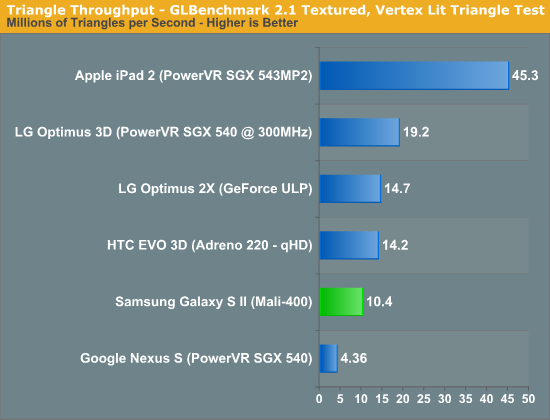
As we move to a more complex triangle test the PowerVR SGX 540 in the Optimus 3D is now only 85% faster than the Mali-400. The Nexus S' performance, despite using the same GPU, is simply abysmal. The Adreno 220 drops to only 37% faster than the Mali-400. No matter how you slice it, the 4-core Mali-400 just can't compete in geometry performance with today's GPUs. Luckily for ARM however, most mobile games aren't geometry bound - what we really need here is pixel processing power and that's something Mali-400 does deliver quite well.
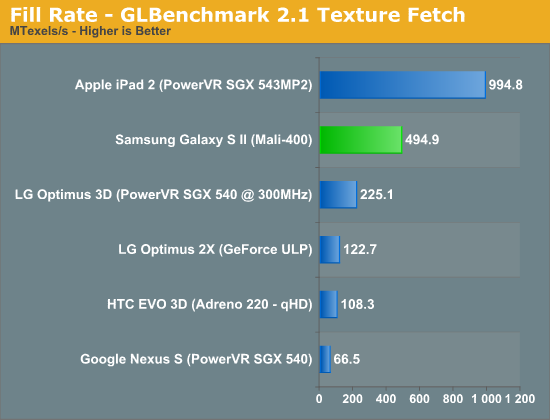
GLBenchmark 2.1's fill test paints a different picture for Mali-400. Here the SGX 540 is less than half the speed while the iPad 2's SGX 543MP2 is about twice the speed. The Mali-400's texturing performance is very solid, no GPU currently shipping in a smartphone can touch it.
What about in a game-like workload? For that we turn to the standard GLBenchmark game tests: Egypt and Pro.
GLBenchmark 2.1—as its name implies—tests OpenGL ES 2.0 performance on compatible devices. The suite includes two long benchmarking scenarios with a demanding combination of OpenGL ES 2.0 effects - texture based and direct lighting, bump, environment, and radiance mapping, soft shadows, vertex shader based skinning, level of detail support, multi-pass deferred rendering, noise textures, and ETC1 texture compression.
GLBenchmark 2.1 is the best example of an even remotely current 3D game running on this class of hardware—and even then this is a stretch. If you want an idea of how the Mali-400 stacks up to the competition however, GLBenchmark 2.1 is probably going to be our best bet (at least until we get Epic to finally release an Unreal Engine benchmark).
First let's look at the 1280 x 720 results from 2.1:
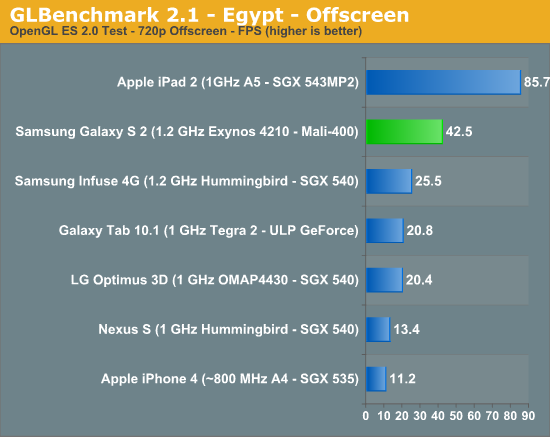
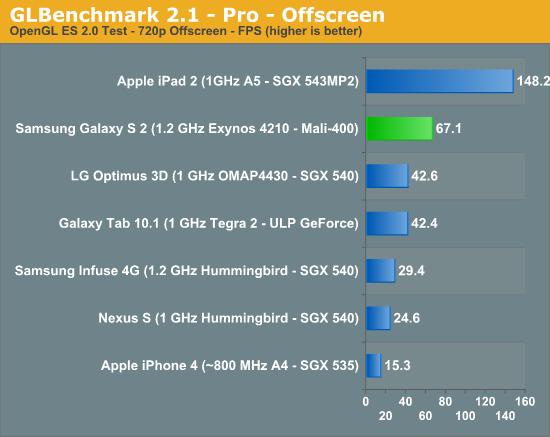
Despite huge disadvantages in geometry performance the Mali-400 does extremely well in the Egypt test, outpacing most of its competitors by a factor of 2. Only the iPad 2 is faster but that's to be expected based on the raw horsepower of its GPU. Given current workloads, ARM's Mali-400 is clearly the fastest GPU available on a smartphone today.
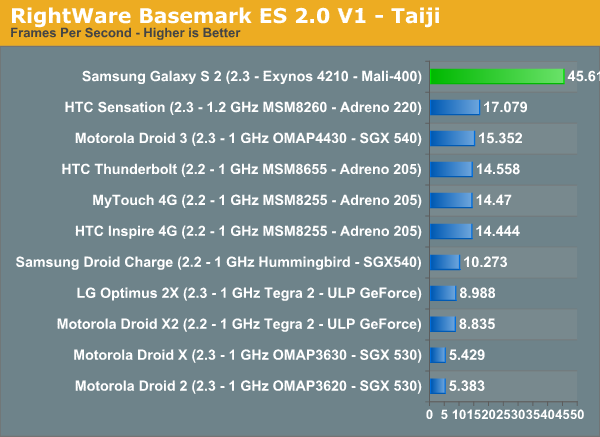
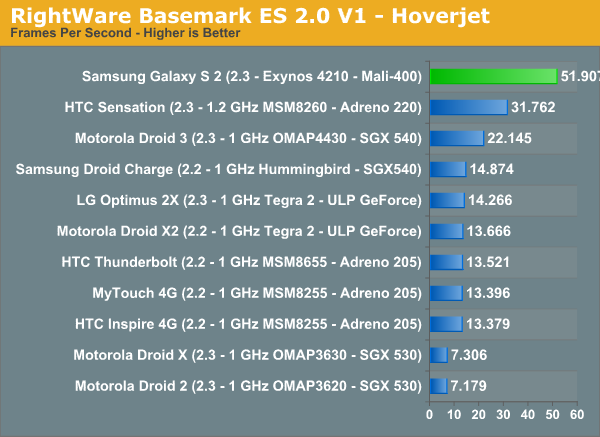
The dominance continues in the Basemark ES 2.0 tests, the Galaxy S II consistently delivers frame rates more than 2x those of its competitors. It's a shame that 3D gaming isn't a bigger deal on Android today because it'd be nice to really see ARM's high end GPU get a chance to flex its muscle on a regular basis.
For comparison to our older phones we've got our standard GLBenchmark 2.0 graphs below:
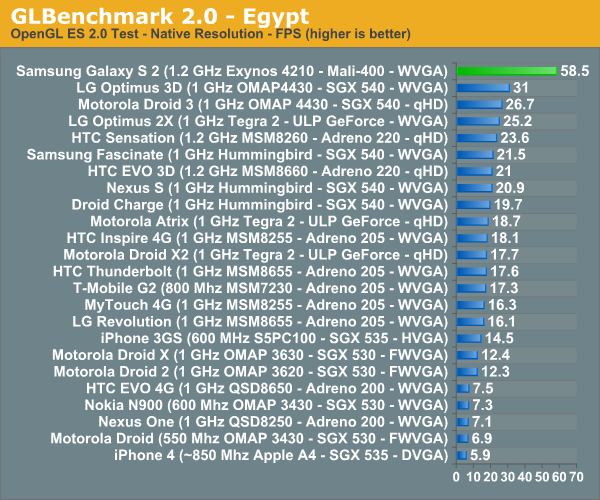

Scrolling Performance
The Galaxy S II is by far the smoothest scrolling Android device we've ever reviewed. Architecturally it has all of the right components to deliver a buttery smooth UI: gobs of memory bandwidth and a very high speed GPU. The software appears to complement it very well. Once again we turn to Qualcomm's Vellamo benchmark to quantify scrolling performance on the Galaxy S II:
| Qualcomm Vellamo Benchmark - Scrolling Performance Tests | |||||
| WVGA Unless Otherwise Noted | Ocean Flinger | Image Flinger | Text Flinger | ||
| HTC EVO 3D (Adreno 220 - qHD) | 68.98 | 26.03 | 41.79 | ||
| Motorola Photon 4G (GeForce ULP) | 62.07 | 17.64 | 35.21 | ||
| Samsung Galaxy S 4G (PowerVR SGX 540) | 55.98 | 26.27 | 31.83 | ||
| Samsung Galaxy S 2 (Mali-400 MP4) | 91.02 | 35.14 | 51.19 | ||
Vellamo produces its scores directly from frame counters, so what you're looking at is a direct representation of how fast these devices scroll through the three web tests above. The Galaxy S II is 20 - 35% faster than the Photon 4G and 45 - 100% faster than the EVO 3D. We simply have no complaints here.
Flash Performance
Thus far NVIDIA's Tegra 2 has delivered the best overall GPU accelerated Flash expierence of any SoC on the market today. With the latest update to Flash enabling NEON support on OMAP 4 both it and the Exynos 4210 now match what NVIDIA delivers here:
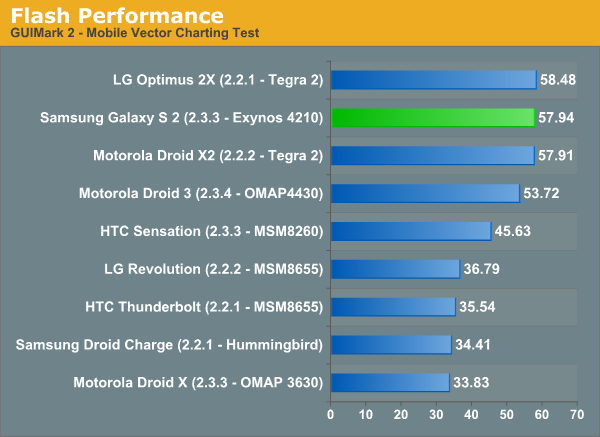
Until we hit 2012 and meet NVIDIA's Kal-El in smartphones (tablet release in 2011) and Qualcomm's first Krait designs, Samsung's Exynos 4210 looks like the best SoC for Android smartphones.










132 Comments
View All Comments
ph0tek - Sunday, September 11, 2011 - link
First of all Android is better than iOS in so many ways that i'd be here all day listing them..... and the same goes for this phones hardware compared to the iPhone so i wont even bother!Secondly the S2 might have a slightly lower display res but it has better response times, infinitely better contrast, vastly better blacks, more vibrant colours, plus superior viewing angles. And all this on a screen that isn't stupidly tiny. It's clearly better overall.
Everyone who i've shown to this phone to instantly says the screen is the best they've seen, even iPhone users.
With the battery theres not much difference, it has longer battery life for talk time than iPhone, and also longer battery when using hotspots, while displaying Flash content too! Yes you can view the WHOLE web on this.
I find it very amusing that you even try to compare the iPhone to this. Theres simply no comparison. Like comparing a ferrari to a skoda. Just makes you look stupid.
niva - Monday, September 12, 2011 - link
Why are you arguing with an iFanboy?LostViking - Saturday, September 17, 2011 - link
You could argue that the SGS 2 is better (for me it wins hands down), and you could argue that the iPhone 4 is better.Some people get sever rashes all over their body by using products not made by Apple ;)
For those people the original iPhone beats the SGS 2 and all future Android devices easily :)
jjj - Sunday, September 11, 2011 - link
hard to like any new phone now when Krait and A15 are around the corner.killerroach - Sunday, September 11, 2011 - link
Remember... there's ALWAYS something around the corner.jjj - Monday, September 12, 2011 - link
Actually there is rarely something like this around the corner.This time we got both new cores and a new node (and the jump from 40/45 nm to 28 nm is pretty big).3lackdeath - Sunday, September 11, 2011 - link
Nice phone but WP7 is faster and smoother.OBLAMA2009 - Sunday, September 11, 2011 - link
400x800? no thxMacTheSpoon - Sunday, September 11, 2011 - link
What a staggeringly awesome review. I am really impressed. The audio section--wow.I sure wish the screen were brighter and the audio better on this phone, but I have to put it on my short list.
Piyono - Sunday, September 11, 2011 - link
"There, Anand and *I* played with..."